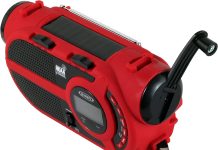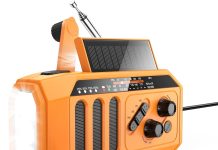Tornadoes are some of the most destructive and frightening forces of nature. They can cause untold amounts of damage and loss in minutes, leaving behind a devastation that takes weeks or even months to clean up.
But where do tornadoes occur most frequently? While it might seem like they’re everywhere, one country stands out regarding tornado activity – but which one?
The answer may surprise you: according to National Oceanic and Atmospheric Administration (NOAA) data, the United States has more tornadoes than any other country.
The sheer size of the U.S. certainly helps contribute to its number of twisters, but this doesn’t fully explain why so many tornadoes strike America’s shores each year.
In this article, we’ll explore what makes the U.S. an attractive target for these mighty storms and which states have seen the highest numbers.
So if you’ve ever wondered why so many tornadoes touch down within our borders every year, read on!
We’ll provide all the facts and figures necessary to understand how vulnerable certain parts of America are to extreme weather events like tornadoes.
Review contents
Definition Of Tornadoes
A tornado is a violently rotating column of air that descends from the base of a thunderstorm.
It’s typically visible as a funnel-shaped cloud and is often accompanied by powerful winds. Tornadoes can cause extensive damage, particularly when they move overpopulated areas. UingUnderstanding these destructive storms helps to know more about their science, characteristics, types, and formation.
Tornado science involves studying various aspects of tornadic activity, including wind speed, path length and width, duration, intensity, and associated weather systems. This information gives scientists valuable insight into how tornadoes form and why some are more intense.
Tornados come in many shapes and sizes with different levels of intensity. A few primary tornado characteristics include size (width), rotation type (cyclonic or anticyclonic), multiple vortices (multiple funnels spinning together), dust whirls (dust devils within the central vortex), gust fronts (a line on the ground marking the leading edge of intense wind), suction spots (areas where extreme low pressure causes objects like cars to lift off the ground), and wall clouds (low hanging clouds at the rear side of an updraft which indicates potential for supercell development).
The Fujita scale was developed to classify tornadoes according to their strength using six categories ranging from F0 (weakest) to F5 (strongest).
Different factors, such as instability in atmosphere layers and temperature imbalances, produce favourable conditions for forming tornadoes. Most tornadoes originate from what’s known as mesocyclones: organized rotating updrafts found within severe thunderstorms that spawn powerful winds near Earth’s surface.
As warm moist air rises from lower altitudes towards higher, colder temperatures in upper atmospheric layers; this creates an area called a ‘shear zone’ where two opposing winds collide, creating violent turbulence and subsequent formation of mesocyclones — eventually resulting in total blown tornadoes if other factors cooperate.
Tornado Hotspots
Regarding tornado hotspots, the United States of America takes the top spot. According to records from NOAA (National Oceanic and Atmospheric Administration), on average, around 1,000 tornadoes touch down in the U.S. each year.
This is more than any other country in the world. Canada also has a high frequency of tornadoes, experiencing approximately 100-200 storms yearly.
Tornado risk varies greatly depending on location within both countries; however, certain areas have higher risks than others.
In the U.S., these include what’s known as Tornado Alley – an area stretching across parts of Texas, Oklahoma, Kansas, Nebraska and South Dakota – plus Florida and parts of Mississippi and Alabama.
Similarly, in Canada, most tornadoes occur in Alberta, Saskatchewan and Manitoba provinces, making up their own ‘tornado alley’.
These regions experience much higher frequencies of severe weather due to a combination of geography and specific meteorological patterns. For example, warm air from the Gulf Coast in springtime moves northwards into Tornado Alley.
Cold air forms over western Canada, leading to storm systems with powerful winds that can create deadly tornadic activity if conditions are favourable.
Understanding these tornado zones can help people prepare for disasters by knowing when peak periods may occur or where dangerous weather might hit next.
Tornado Activity In Different Countries
The frequency and severity of tornadoes vary significantly from country to country. The United States has the highest number of tornadoes on record, with an average of over 1,200 annually.
Canada follows closely behind, with almost 800 annual tornado events reported. Europe’s total is only around 200 annually, while Australia sees less than 50 annually.
Tornado activity also varies within countries due to regional differences in weather patterns. For example, the U.S. states with the most frequent tornadoes are Texas and Oklahoma.
These two states account for over one-third of all recorded U.S. tornado events yearly. On the other hand, some parts of Canada experience very little tornado activity despite its overall high numbers.
There is still a great deal to be learned about why some regions experience higher rates of storm intensity and subsequent tornado development than others.
Research into this area continues as scientists strive to gain better insight into how we can best protect ourselves from these dangerous storms in the future.
Tornado Intensity And Duration
Tornado intensity and duration are two key factors determining the severity of a tornado’s impact. Tornadoes can range in intensity from weak to vigorous, with some tornadoes reaching wind speeds exceeding 300 mph.
The strength of a tornado is determined by its Fujita Scale rating, which measures damage potential and corresponds to wind speed ranges. Tornado duration also varies greatly depending on conditions; most tornadoes last less than 10 minutes, but there have been instances where they have lasted for hours.
The impact of a tornado depends mainly on its intensity and duration. In destruction, stronger tornadoes tend to cause more devastation than weaker ones due to their higher wind speeds and longer durations.
In addition, specific structures may be more vulnerable to the effects of high-intensity winds than others. For example, mobile homes are highly susceptible to severe weather events because they often lack proper anchoring systems or additional protection features like storm shutters or reinforced walls.
Knowing the intensity and duration of a tornado gives us an idea of its potential consequences and any necessary precautionary steps we should take to protect ourselves and our property from harm during such storms.
Knowing this information helps people stay safe while minimizing the risk associated with these powerful storms.
Factors Influencing Tornado Occurrence
Moving on from tornado intensity and duration, we now consider the factors that influence tornado occurrence.
Tornadoes are most common in Tornado Alley, a region of North America stretching through the Great Plains into parts of Canada and Mexico. However, there has been debate over which country sees the highest frequency of tornadoes.
Tornado conditions arise when warm air meets cold air along with strong winds; these three elements must be present for a tornado to form. Additionally, climate change can affect the environment’s ability to produce tornadic weather.
Wind shear also plays a vital role as it increases rotational energy within thunderstorms, thus providing additional energy for possible tornado formation.
And finally, storm systems such as mesocyclones bring about favourable conditions for a tornado.
To summarize what influences tornadoes:
- Warm/cold air fronts meeting with wind generate the necessary conditions for them to form
- Climate change affects how often and where they may appear
- Wind shear adds rotational energy and enhances the probability of their development
- Mesocyclones create unifying pressure fields leading to more frequent instances of them happening
While there is still some disagreement on which country has experienced the most significant number of tornados historically, research suggests North America experiences far more than any other part of the world due to its unique topography and meteorological dynamics.
Most Common Months For Tornadoes
The United States is known to have the most tornadoes in any given year, but it isn’t the only country with tornado activity. Countries such as Canada and Australia also experience their fair share of twisters.
When looking at which months are more prone to tornadic storms, there seems to be a pattern among countries that experience frequent tornado outbreaks. Generally speaking, the peak time for tornadoes occurs during late spring and early summer.
In the U.S., peak tornado season typically starts in May and ends by mid-July; this coincides with when warm moist air from the Gulf Coast regions meets cooler, drier air from the north.
During these months, thunderstorms often become severe enough to produce twisters. Other areas worldwide have similar patterns regarding the monthly frequency of tornadoes: Canadian provinces usually see maximum activity between June and August, while Australian states tend to observe higher frequencies of tornadoes from October to November.
No matter what part of the world you live in or where you travel, understanding local climatic conditions can help you prepare for potential tornado hazards throughout various months.
Tornado month patterns vary slightly within different countries, but they all generally follow a similar trend of increased tornado frequency during warmer parts of the seasons.
Knowing how weather affects your area’s risk level will help keep you safe should a storm develop near you – no matter what month it may be!
Damage Caused By Tornadoes
Moving on from the most common months for tornadoes, it’s time to discuss the damage they can cause. Tornadoes are capable of causing immense destruction in a relatively short time and have been known to leave entire towns decimated in their wake.
The cost associated with tornado destruction is hard to calculate as every situation varies depending on its intensity and location; however, some estimates place the average cost at around $2 billion per year globally.
The scale of tornado destruction also varies based on strength and size, ranging from minor property damage, such as broken windows or downed trees, all the way up to complete obliteration of buildings and homes.
There’s no one-size-fits-all answer to estimating how much damage a tornado will cause; this depends mainly on where it strikes, how powerful it is, and what type of structures are present.
Risk levels depend heavily upon geographical location; according to recent research, the United States has reported more tornadoes than any other country since 1950 – making it the nation most prone to tornado damage worldwide.
As climate change continues to wreak havoc across our planet, these destructive storms may become even deadlier in years ahead if we don’t mitigate their impacts.
For those living in areas that experience regular tornadic activity, staying informed about weather conditions and having an emergency plan ready is essential for keeping safe during severe storm events.
Preparing For A Tornado
Preparing for a tornado is essential to keeping you and your family safe. To be ready, one should always have an emergency kit in case of any natural disaster. It should include flashlights, batteries, water bottles, non-perishable food items, first aid supplies, and other necessities.
Additionally, make sure everyone knows where the closest storm shelter is located. If there’s no nearby shelter, identify a secure place inside the home to protect against flying debris.
When a tornado warning has been issued, paying attention to all weather alerts and taking immediate action when needed is essential.
Have an evacuation plan established ahead of time so everyone knows what to do in the event of an emergency. Don’t wait until the last minute, which increases stress levels and could cause confusion among household members.
Finally, stay informed about current weather conditions by monitoring local news sources. Sign up for automatic notifications from your county office or national weather service for additional safety tips throughout the severe weather season.
Knowing when a tornado may strike will give you more time to react quickly and prepare accordingly.
Investigating The Causes Of Tornadoes
Now that we have discussed how to prepare for a tornado let’s explore what causes them. Tornadoes are created when certain atmospheric ingredients come together to create turbulent storms.
These ingredients include warm and cold air masses interacting with each other, high levels of atmospheric moisture, and significant differences in barometric pressure. When all these components combine, it can trigger the formation of a powerful rotating column of wind known as a tornado.
The first step in understanding why tornadoes form is to look at the interactions between different temperatures of air and their effects on atmospheric pressure. Warm air rises due to its lower density than cooler air, creating low-pressure areas near the ground, which act as a vacuum drawing more warm air up from below.
Simultaneously, cool air descends into an area near the surface with higher pressure than above, pushing down on any warmer layers beneath it. The combination of rising hot air and descending cooler air creates an unstable environment ideal for forming severe weather systems like thunderstorms and tornadoes.
Tornado development also relies upon plenty of water vapour in the atmosphere, which helps fuel convective activity by releasing heat energy when it condenses into clouds. High winds associated with storm fronts can further increase instability within the atmosphere by intensifying vertical wind shear – a measure of how quickly wind speed or direction changes when moving upwards through the atmosphere – making it easier for rotation to take place within cloud formations such as supercell thunderstorms which often spawn devastating twisters.
To understand why some countries experience more tornadoes than others, it becomes clear that they must possess favourable environmental conditions conducive to producing intense thunderstorms capable of generating destructive vortices in abundance over time.
For example, researchers believe North America has one of the highest concentrations of tornadic activity anywhere in the world due mainly to its diverse landscape featuring varying temperature ranges along with plentiful sources of humidity and strong winds sweeping across vast open plains throughout much of its interior regions.
Understanding Long-Term Trends In Tornado Activity
Tornado activity around the world varies significantly by region. Generally, the United States has far more tornadoes than any other country every year, with some states having exceptionally high tornado frequency.
To better understand long-term trends in tornado activity, it is essential to examine seasonal and annual tornado occurrence records.
For example, data from the National Climatic Data Center’s (NCDC) Storm Events Database shows that there have been an average of 1,200 reported tornadoes each year since 2000 in the U.S.
This number has steadily increased over time due to improved reporting techniques and increased observational capabilities. Additionally, most tornadoes tend to occur during specific periods of the year, such as springtime in Tornado Alley or summer months across much of the Midwest and South.
It is also possible to compare regional differences in tornado frequency. According to NCDC records, Texas had nearly double the amount of tornadoes compared to second-place Oklahoma for 2020—a common trend was seen in recent years.
Furthermore, even within regions experiencing heavy tornado activity like Tornado Alley or Dixie Alley (the southeastern U.S.), individual states can experience vastly different amounts of storms depending on their particular geography and climate patterns.
Examining these long-term trends helps us gain valuable insights into how severe weather events change over time and what areas may be at the most significant risk for future tornadic activity.
Frequently Asked Questions
What Is The Difference Between A Tornado Watch And A Tornado Warning?
Understanding the difference between a tornado watch and a tornado warning is essential when it comes to tornado safety.
A tornado watch means conditions are favourable for tornadoes to form in the area, while a warning signals an imminent threat of severe weather.
When a tornado warning is issued, people should immediately protect themselves from potential harm.
Understandably, those living in areas prone to tornadoes may feel anxious or overwhelmed when faced with a weather alert.
It is essential to know what steps to take if you encounter either type of notification. Here are four essential tips:
1. Follow local news reports closely for updates on any developing storms;
2. Have an emergency plan and supplies ready in case your family needs to evacuate quickly;
3. Identify safe rooms or shelters in advance; and
4. Educate yourself about recognizing signs of impending storms, such as hail or strong winds.
By being aware of these steps, individuals can be better prepared for any potential danger posed by extreme weather events like tornados.
It’s also important to remember that while having a plan helps ensure safety during dangerous conditions, sometimes unpredictable factors will come into play, so staying informed and vigilant remains critical.
What Is The Deadliest Tornado Ever Recorded?
The deadliest tornado ever recorded is essential when discussing extreme weather events.
Throughout history, tornadoes have caused immense destruction and death in many countries worldwide.
To understand some of the worst storms documented, it’s necessary to look at what makes a tornado so deadly and how they can be measured against one another.
When considering a “deadliest” tornado, there are several factors to take into account:
- Tornado fatalities: The number of people who died due to a particular storm.
- Tornado intensity: How strong the winds were during the event (measured using the Fujita scale).
- Recorded tornado history: Whether or not records exist for a specific storm from reliable sources.
The most destructive hurricane occurred in Bangladesh in 1970, killing approximately 300,000 people with wind speeds reaching up to 250 mph (400 km/h). This devastating event was followed by two other severe tornadoes in India and Pakistan within three years of each other; both claimed more than 1,500 lives each time.
Other notable events include the 2011 Joplin, Missouri disaster, which resulted in 158 deaths and extensive damage along its path due to high winds between 200–210 mph (322–338 km/h) and an EF5-rated twister that struck Moore, Oklahoma, in 2013 causing 24 fatalities.
No matter how intense or powerful these storms may be, taking precautions before any forecasted extreme weather event is essential for keeping people safe from harm’s way.
Knowing about some of our planet’s most disastrous episodes is an important reminder that safety should always come first when dealing with natural disasters like tornadoes.
What Is The Best Way To Stay Safe During A Tornado?
Staying safe during a tornado is a crucial safety measure. Tornadoes can be extremely dangerous and often destroy property and cause death, so understanding the best way to stay safe is crucial.
Several key steps should be taken when preparing for a tornado, such as having a tornado safety plan in place, creating a safety checklist, and following specific safety precautions.
When it comes to staying safe during a tornado, a solid plan is essential. Developing a tornado safety plan includes researching evacuation routes and identifying locations where you can take shelter if necessary.
It’s also essential to have emergency supplies prepared ahead of time, such as food and water rations, flashlights with extra batteries, and first aid kits. Once your plan has been created, practice it with family members or other individuals accompanying you on your evacuation route.
Another important step when planning for a potential tornadic event is creating a tornado safety checklist outlining all the items needed to complete your plan safely. This checklist may include things like obtaining weather radios or apps so that you can receive updated warnings quickly; ensuring that everyone in the household knows how to shut off utilities properly; stocking up on non-perishable food items; gathering any prescription medications; collecting identification documents; packing clothes appropriate for cold temperatures; and assembling emergency kits containing medical supplies, communication devices (such as cell phones), cash/credit cards, blankets etc. All these items should then be packed into waterproof containers ready for quick access when required.
By taking the proper measures before disaster strikes—creating an effective plan by researching evacuation routes, ensuring everyone understands protocol details within the plan, and developing checklists outlining what needs to be done—, you can maximize your chances of surviving even the most destructive tornados unscathed.
How Does Climate Change Affect Tornado Intensity?
As we consider the effects of climate change on tornado intensity, it’s essential to understand how weather patterns and environmental changes impact these powerful storms.
Climate change has been linked to an increase in both tornado frequency and severity, making it more essential than ever that people stay informed about potential danger.
Studies have shown that warmer air can hold more moisture, allowing for more energy buildup in a given area. This often leads to stronger thunderstorms with higher winds, two significant factors in the formation of tornadoes.
Rising temperatures may also lead to changes in wind speed and direction at different levels of the atmosphere – creating updrafts or downdrafts that help create rotating solid storm systems capable of producing deadly twisters.
Changes in temperature and humidity due to climate change can also influence other aspects of tornado development, such as duration and size.
Warmer air combined with increased precipitation could cause severe rain events lasting longer and covering larger areas than typically seen during traditional weather patterns. This could mean an even greater risk of property damage and loss of life during extreme weather events.
It is clear from this evidence that understanding how climate change impacts our environment should be taken very seriously by all those living within affected regions.
By staying aware of changing weather conditions and taking proper safety precautions, individuals can protect themselves from any potential risks these devastating storms pose.
What Is The Difference Between A Tornado And A Hurricane?
Tornadoes and hurricanes are severe weather events that can cause significant damage, but there are some critical differences between the two. Firstly, tornadoes form from thunderstorms, whereas hurricanes form over warm ocean waters.
Secondly, tornado warnings typically last an hour or less, whereas hurricane watches may last several days before a warning is issued. Finally, the intensity of a tornado is usually much higher than a hurricane’s.
When looking for signs of a potential tornado, look out for dark, low-lying clouds in the sky and heavy rains. Tornadoes develop quickly and often occur with little warning, making them extremely dangerous when they strike.
Tornado warnings will be issued by the National Weather Service if there is imminent danger due to high wind speeds and extreme rain conditions. It’s essential to take these warnings seriously and seek shelter immediately when necessary.
On the other hand, hurricane watch statements indicate that tropical storm winds could reach at least 74 miles per hour (119 km/h) within 48 hours. Once this threshold has been reached, a hurricane warning and evacuation orders are usually issued should circumstances require it.
Hurricanes tend to move slowly, so people have more time to prepare ahead of landfall than tornadoes, which travel faster and can change direction suddenly without warning.
It’s clear that while both tornadoes and hurricanes pose severe risks in terms of their intensity and destructive potentials, they differ significantly in how they form, how long they take to develop into full-fledged storms, and most importantly – how much time we’re given to prepare ourselves before disaster strikes.
Conclusion
The consequences of tornadoes can be devastating, and their unpredictability makes them even more frightening. It’s essential to understand the difference between a tornado watch and a warning to be prepared if one occurs.
Staying safe during a tornado requires being aware of your surroundings and taking cover in an appropriate place as soon as possible. Additionally, climate change has been linked to an increase in intense storms like hurricanes and tornadoes, making it ever more essential for us to take preventative action against global warming.
No matter where you live, staying informed about how severe weather might affect your area is wise. Knowing what country has the most tornadoes can help people prepare better for potential disasters.
The United States is considered to have the highest number of tornadoes per year, but other countries also experience similar levels of destruction due to these severe weather events.
We must continue learning more about tornadoes and their interactions with our environment. Understanding the differences between a tornado and a hurricane could help save lives when extreme weather strikes.
By educating ourselves on proper safety protocols, we can protect ourselves from danger when these natural disasters strike.



































